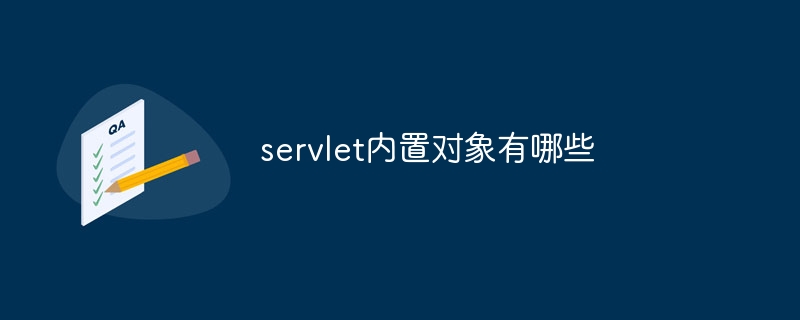Home >Common Problem >What are the built-in objects of servlet?
What are the built-in objects of servlet?
- zbtOriginal
- 2023-11-21 16:01:301247browse
Servlet built-in objects include ServletRequest, ServletResponse, HttpSession, ServletContext, ServletRequestDispatcher, ServletConfig, ServletOutputStream, PrintWriter and ServletInputStream.

The operating system for this tutorial: Windows 10 system, DELL G3 computer.
In Java Servlet , there are some predefined objects called built-in objects, which provide convenient access and manipulation of the functions provided by the Servlet container. These built-in objects include ServletRequest, ServletResponse, HttpSession, ServletContext, ServletRequestDispatcher, ServletConfig, ServletOutputStream, PrintWriter, ServletInputStream, etc. Next we will introduce the role and usage of each built-in object in detail.
1. ServletRequest: ServletRequest Represents the information requested by the client. It provides methods and attributes related to the client's request, including request parameters, header information, URL, etc. Developers can obtain various parameters of the request through ServletRequest and use them to process the request. Through the methods of the ServletRequest object, developers can obtain request parameters, request headers, requested URL, parameter parsing, etc.
2. ServletResponse: ServletResponse Represents the response of a Servlet. It provides methods and properties for sending responses to the client. Through ServletResponse, developers can set the content type, encoding, and response status code of the response, and send data to the client. Developers can use the methods of the ServletResponse object to set the response content type, encoding, status code, and send data to the client.
3. HttpSession: HttpSession Represents the user's session, which provides session properties and methods for tracking the user's session status. Through the HttpSession object, developers can store user-related information in the session to achieve cross-page information transfer and user status maintenance.
4. ServletContext: ServletContext Represents the context of a Servlet, which provides information about a Web application and methods and properties that access the Web application's resources. Developers can obtain the initialization parameters, context path, access resources, and obtain other Servlets of web applications through the ServletContext object.
5. ServletRequestDispatcher: ServletRequestDispatcher Used to forward requests and include other resources in Servlets. Through it, you can obtain the output object of another resource in the Servlet, or forward the request to another resource and execute the response of the resource.
6. ServletConfig: ServletConfig Represents the configuration of the Servlet, which provides the methods and properties of the Servlet's initialization parameters and context. Through the ServletConfig object, developers can obtain the Servlet's initialization parameters and the Servlet's context.
7. ServletOutputStream: ServletOutputStream Represents the Servlet's output stream, which provides a method for sending binary data to the client. Through the ServletOutputStream object, developers can send binary data to the client.
8. PrintWriter: PrintWriter Represents the Servlet's output stream, which provides a method for sending text data to the client. Through the PrintWriter object, developers can send text data to the client.
9. ServletInputStream: ServletInputStream Represents the Servlet's input stream, which provides a method to obtain data sent by the client. Through the ServletInputStream object, developers can obtain the request data sent by the client.
These built-in objects are in Java Servlets play an important role in the Servlet container. Through them, you can easily access and operate the functions provided by the Servlet container. These functions include processing requests, sending responses, tracking sessions, obtaining Web application information, obtaining initialization parameters, etc. Understanding and mastering the usage and role of these built-in objects is crucial to developing Servlet applications with high performance and complex functions. By properly using these built-in objects, developers can develop fully functional Servlet applications more efficiently.
The above is the detailed content of What are the built-in objects of servlet?. For more information, please follow other related articles on the PHP Chinese website!

